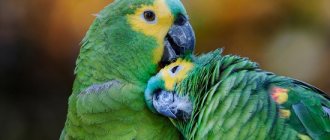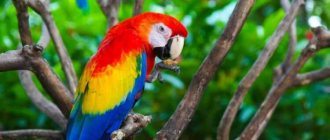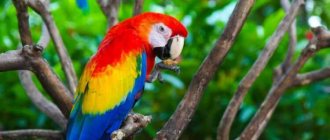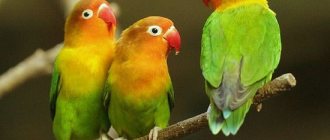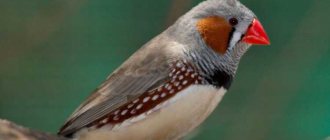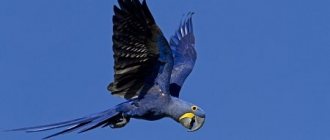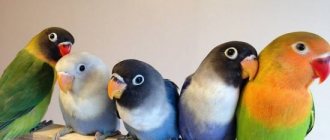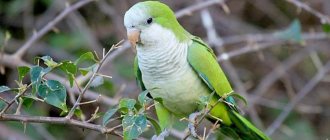Among the many species of ornamental birds, small parrots are the most sought after. This popularity is explained not only by the simplicity of maintenance, but also by the amount of positivity emanating from these birds. Miniature birds are funny, cute and smart. They are excellent conversationalists: they will always listen to their owner and even “support” the conversation. From this material you will learn about the tiniest parrots on the planet: what they look like, where they live in nature, how long they live and what conditions they need.
Budgerigar
The budgerigar is the most famous and popular species of small parrots. It is found in Australia. The budgerigar is easily tamed, is not shy and loves to communicate with people. Males easily learn to repeat words and phrases.
The size of the budgerigar is about 20 cm, body weight is 40-45 g. The natural color of the representatives of the species is green. The head and wings are yellow with a black wave-like pattern, the tail is turquoise. Breeders have bred many breeds that differ in color. The most popular are blue and yellow parrots.
The sex of a budgerigar can be easily determined by the color of the wax beak. In young males it is lilac, in adults it is bright blue. In young females the cere is blue with a light rim around the nostrils; in adult females ready for reproduction, it is brown.
Varieties of small parrots
Beginning breeders are recommended to have small parrots, since keeping and caring for them is not difficult compared to keeping large parrots. They are also quite easy to breed.
But the advantages of small parrots are obvious:
- take up little space;
- much less destructive and noisy than large species of parrots;
- food, a cage and accessories for it are quite affordable, many of them, for example, the same cage, can be made with your own hands;
- prices for small breeds of parrots are an order of magnitude lower than for other species.
Wavy
One of the most popular feathered pets is the Australian budgerigar. The natural color is light green, however, thanks to selection, about 200 color varieties can be found at home.
- Body dimensions from head to tail are only 17-19 cm, of which the tail accounts for more than half - 9-10 cm.
- Maximum weight 45 grams.
- Thanks to the wave stripes throughout the body, the birds got their name, although now there are also solid-colored varieties (yellow, blue, dark green, blue and others) that do not have these waves.
- They have a strong beak of small size.
- They are very fast in flight - in the wild, wild wavy birds can reach speeds of 120 km/h.
The lifespan of these active birds under good conditions can reach 15-20 years.
Budgerigars are excellent talkers. If you work with them, they are able to learn and readily reproduce several dozen words and phrases. True, only boys have this ability.
Quite a talkative and noisy species of bird. They can tweet all day long, deftly shouting over a running TV or people talking. Very playful and friendly. They are not particularly demanding in terms of living conditions and are excellent friends with children. By the way, if you are thinking about what kind of parrot to get for your child, a budgie is the best option.
Passeriformes
This species of small parrots, natives of America, is also easy to keep, but is not justifiably very popular among breeders.
The natural color of parrots is green. Thanks to selection, blue, cream and yellow birds appeared.
- The body size is no more than 14.5 cm - for the “passerine” size of the birds they were called passerines.
- Weight only 30 grams.
- The tail of birds is peculiar: short wedge-shaped or rounded.
- The beak is light, quite wide, and also widens on the sides.
Lovebirds
Lovebirds are small parrots that live in Africa and Madagascar. Representatives of this genus are characterized by strong affection between the male and female. In captivity, they can be kept in pairs or alone, but when kept alone, the owner must pay enough attention to the bird.
The body length of lovebirds reaches 10-17 cm, and their weight is 40-60 g. The body is strong, the head is large, the tail is short, and the beak is strong. Color depends on the species; most often the plumage contains green and yellow shades. The genus of lovebirds includes 9 species:
- collar;
- mask;
- red-faced;
- rosy-cheeked;
- grey-headed;
- black-cheeked;
- black-winged;
- Liliana;
- Fisher.
Lovebirds raised by their parents never become completely tame and cannot be trained. To get tame birds, it is necessary to take the chicks from the nest shortly before departure and feed them artificially. Such parrots become strongly attached to their owner, but require a lot of attention and cannot stand loneliness.
Eclectus
One of the most colorful green parrots is the Eclectus. Eclectus is sexually dimorphic, meaning you can tell the sex of a bird by its plumage. If you spot a large, bright green parrot with a distinct orange beak, chances are you've seen an eclectus. Females are mostly bright red. These birds are very sociable and affectionate, but can easily become stressed if they feel neglected.
Passerine parrot
Passerine parrots are small parrots native to Central and South America. Their body dimensions do not exceed 15 cm, and their weight is 30 g. The body is compact, the tail is short, and the beak is large. Color depends on the species. The natural color includes predominantly green shades, but breeders have developed blue, yellow and cream morphs.
The genus has 7 species:
- parakeet;
- yellow-faced parakeet;
- Mexican parakeet;
- Lesson's parakeet;
- spectacled parakeet;
- blue-winged parakeet;
- dark-billed parakeet.
All representatives of the genus are well tamed and willingly make contact with humans. They are social birds, so it is best to keep them in pairs; When kept alone, the owner must pay a lot of attention to the pet. Passerine parrots have a quiet voice and are not prone to excessive noise. They are able to remember and reproduce human speech (up to 10-15 words).
Choosing a small parrot
From the species of small parrots presented here, you can choose a pet according to your interests:
- if you love communication, constant liveliness in the house and want your pet to talk, get a budgie - you will like these talkers;
- if you want your house to be filled with chirping, but cannot devote much time to your pets, get a couple of lovebirds - you will get great pleasure watching these birds;
- If you don’t like noise and restless fuss, but are happy to play with your pets, get passerines - you will be interested in them, especially since one day they can speak, imitating human speech.
Parakeet
woodpecker parrot
The Woodpecker Parrot is the smallest parrot in the world. Lives in New Guinea and nearby islands. The body length of an adult does not exceed 10 cm, and the weight is 15 g. The body is compact, the head is large, the tail is short, shaped like a woodpecker’s tail. The color of the plumage is predominantly green; Depending on the species, the color may include red, blue, yellow, black and brown.
The genus of woodpecker parrots includes 6 species:
- Bruina;
- Finsha;
- Schlegel;
- Salvadori;
- Meeka;
- Sclater.
Woodpecker parrots get used to humans, but do not become completely tame. They cannot reproduce human speech. These birds should be kept in a spacious enclosure where they can fly. In nature, these parrots feed mainly on nectar, tree sap, fruits and soft shoots of plants. In captivity, their diet should consist of fresh fruits, greens and a liquid mixture of milk, wheat flour, and chopped nuts.
Types of parrots with green plumage
Among the many breeds of green parrots, varieties such as eclectus, amazons, soldier's macaws, monks, necklaces and wavy ones deserve special attention.
Eclectus
A fairly large green parrot, 35-40 cm long and weighing 360-450 g. It has a short square tail, gray paws, long, beautifully rounded wings and a large beak with a smooth glossy upper beak.
The male is covered with green plumage, tinged with yellow on the head. The bottom of the tail is yellow with a greenish tint, the sides are red, the flight feathers are blue with green edges. The upper part of the beak is colored red or orange, the lower part is black. The female is covered in red or red-brown plumage with a blue belly, breast and nape.
There may be violet-blue eye rings around her eyes. The beak is black, the iris is light yellow.
Interesting! Because of such noticeable differences in plumage color, ornithologists have long been convinced that red and green eclectus parrots belong to different species. But thanks to observations of the behavior of birds during the mating season, they came to the conclusion that it was a female and a male.
Eclectus inhabit Australia, New Guinea and adjacent islands. They are found in coconut groves and dense tropical forests and nest in tree hollows. During the day, the birds spend time alone or in pairs, and at night they gather in small flocks. They feed on plant foods and often raid corn fields and oil palm plantations.
Amazon
This is a typical American species of green parrot , whose distribution range is Central and South America. It lives in warm, humid tropical forests and savannas.
This breed of green parrots is large in size. Birds grow up to 25-45 cm in length and weigh between 300-700 g. Amazons have a short rounded tail, small wings and a powerful beak, which can easily crack nuts. This species of bird is easily recognizable by its variegated bright green plumage with colored spots on the wings, tail, back of the head, head and neck.
Interesting! According to various classifications, Amazons are divided into 26-32 species, 18 of which are listed in the Red Book, 1 is under the close supervision of ornithologists and 2 are considered extinct.
Small flocks of Amazons spend most of their time in the trees. American green parrots make a lot of noise and only become silent after dark. After waking up, the Amazons take roll call and during the day they accompany all their actions with loud screams.
These green parrots are considered one of the best sound mimics. They skillfully copy various melodies, voices of people and animals.
Ruffled parrot
These green parrots live in the African tropics and almost throughout South Asia. They live in forests and spend time in the crowns and hollows of trees. Birds are grouped in large flocks, the number of which sometimes reaches several hundred birds.
Necklace parrots are medium in size and grow up to 30-60 cm with a weight of no more than 150 g. They have short, poorly developed legs, a large strong red beak, pointed wings and a narrow stepped tail. The birds are covered with grass-green feathers with a yellowish tint. And on the neck of males there is a bright, dark-colored “necklace”.
On a note. Green parakeets with red beaks have an alternative name - they are called ringed or Cramer's parakeets.
In their homeland, birds are not considered exotic and often live close to people. Flocks of green parrots raid agricultural crops and orchards, causing significant damage to farmers. They often leave forests altogether and move to large cities.
Soldier's Macaw
These green parrots are found in Nicaragua, Panama and Costa Rica. They live in humid tropical valleys and dry areas at altitudes up to 700 m above sea level. Birds live in pairs or family groups.
The soldier's macaw is a large green parrot, it grows up to 80-85 cm in length and weighs 900-1000 g. The bird has gray paws, a black beak and a light yellow iris. The parrot's body is dominated by green plumage with a slight yellowish tint. The undertail, underwings and back are yellow-bronze, the head is light green with small black splashes in the facial area.
The cere and forehead are red, the back of the head is greenish-blue. The bird's flight feathers, tail feathers and coverts are blue. The tail is brown with blue tips.
The Soldier's Macaw is a sociable and good-natured green parrot that makes an excellent family pet. He easily makes contact with people, but sometimes he is capricious. This green parrot subtly senses its owner's mood and is able to copy other people's emotions.
Parrot monk
This green parrot received the name “monk” due to the unusual colors associated with the cloak of clergy.
These green parrots inhabit the northern regions of Argentina, southern Brazil, Greece, Spain, the Bahamas, Italy, Bolivia, Uruguay and Paraguay. They live in palm groves, dense forests and mountainous slopes at altitudes up to 3000 m above sea level. Birds, also called Quakers, gather in flocks of 200-500 individuals and sometimes move closer to people.
On a note. Green Quaker parrots destroy cereal crops and raid orchards. Therefore, they are considered pests and in some countries they are even shot.
Monk parakeets grow up to 30 cm and weigh 100-150 g. They have long wings, a narrow stepped tail and a thick, curved beak of a nut-brown color. The back, nape and wings of the bird are covered with yellowish-green plumage. The chest, neck, forehead and crown are ash-gray, the belly is gray with a greenish tint. The tail is blue-green, the flight feathers are blue with bright blue tips.
Quakers are cheerful, sociable and easy to tame parrots. They get along well with people and other pets as they see them as part of their pack. Green monk parrots are able to memorize up to 200 words and understand their meaning. Quakers can hum various melodies and can imitate laughter, sneezing, coughing and other sounds.
Wavy
Australia is considered the homeland of these small parrots. Their natural habitat covers the eastern and southwestern coasts of the continent and the territory of nearby islands. They gather in noisy flocks and inhabit meadows, savannas, eucalyptus thickets and forests.
Interesting! During flight, budgies can reach speeds of up to 120 km/h. Thanks to this, the birds manage to escape from predators.
Budgerigars grow up to 17-20 cm and weigh 40-45 g. They have a long stepped tail, which makes them appear larger than they actually are. The natural color of budgies is green. The throat and front part are colored yellow, and there are blue spots on the sides of the head. Black waves run along the back of the head and upper parts of the body. These small parrots have a strong curved beak, with which they carry various objects, move along branches and defend themselves from enemy attacks.
Green parrots are beautiful birds with camouflage coloring that helps them survive in their natural environment. Thanks to it, birds easily blend into the surrounding vegetation and remain unnoticed.
Fig parrot
Fig parrots are small parrots native to Australia and New Guinea. Their body dimensions do not exceed 14 cm, and their weight is 35 g. The genus includes 2 species: black-cheeked and golden-sided fig parrots. The main body color of representatives of both species is green. The golden-sided parakeet has yellow sides and blue and red feathers on its head and wings. The black-cheeked parrot has a white and blue head with black markings on the cheeks, a red breast, and blue feathers on the wings.
These birds are poorly tamed, do not learn human speech, and are rarely seen in captivity. The basis of their diet in nature is figs and nectar, as well as seeds, flowers, berries and fruits. When kept in captivity, it is important to provide adequate nutrition. Fig parrots will need a spacious cage or aviary where they can fly freely. They are kept in pairs or small groups. Birds have a quiet voice and are not prone to excessive noise.
Description
The habitat of parrots is the tropical and subtropical regions of America and Australia. Various species have their own special, unique color, size, and habits. These birds have won the hearts of bird lovers. And all thanks to their cheerful disposition, curiosity, restlessness, and positivity that they radiate to others.
Content Features
To keep a parrot you will need a rectangular cage. Its size should be such that the bird can freely spread its wings and fly from perch to perch. For ease of cleaning, you should choose a cage with a retractable tray. The cage contains:
- wooden perches of such a diameter that the parrot cannot completely wrap his fingers around them;
- two feeders - for dry and succulent food;
- drinking bowl;
- bathing suit;
- toys (wooden or rope);
- mineral supplements (sepia or special mineral stone).
The cage is placed near the wall at the level of the person’s face. It should not be in a draft or in the aisle. Tamed birds can be released from the cage to walk around the room. The water in the drinking bowl and bathing basin is changed daily or more often as it gets dirty. The diet should include:
- grain mixture;
- vegetables;
- fruits;
- greenery;
- boiled egg;
- low-fat cottage cheese;
- porridge cooked in water;
- insects
You can place branches of fruit trees in the cage, which serve as toys for parrots and a source of nutrients. In addition, birds are offered toys purchased at a pet store or home-made toys. They should be made from natural materials and not contain paint, which may be toxic to birds. Toys can be intended for:
- grinding off beak and claws;
- climbing and hanging (ropes, swings, ladders);
- environmental enrichment (educational toys).
On a note! Toys that make sounds are not recommended to be placed in a cage. They can cause stress in birds and also distract parrots from interacting with humans and remembering words.
Health and life expectancy
The lifespan of small feathered birds ranges from 5 to 20 years and depends on what species they belong to. Woodpeckers have the shortest lifespan. But these birds can live up to 15-18 years.
Small parrots do not have a strong immune system and often contract infections. Therefore, at the first symptoms of the disease or any deviations in the behavior of birds, you should contact a veterinarian.
Due to their small size, small parrots often get injured when they get tangled in curtains or bump into window frames. They may also be preyed upon by other pets or abused by their owner's children. Therefore, the bird should not be released from the cage unattended.
Small parrots are quite curious and often drown in pots of water, get poisonous fumes or get burned. They also have a weak heart and are prone to stress. That's why you should protect these birds from emotional outbursts.
